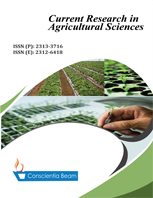Assessment of enset root mealybug (Cataenococcus ensete) Williams and Matile-Ferrero (Homoptera: Pseudococcidae) in enset-growing areas of Ari Zone, South Ethiopia
DOI:
https://doi.org/10.18488/cras.v12i1.4081Abstract
This survey assessed the prevalence, incidence, distribution, and existing farmers' practices of root mealybug on enset (Ensete ventricosum), an important crop widely cultivated in Southern Ethiopia, such as the Ari zone. The study aimed to provide information to develop sustainable pest management. A survey was conducted in two woredas during the 2023/2024 cropping seasons. Fourteen (14) kebeles were purposively selected based on enset production potential. Data were collected through stratified random sampling across 95 farms, covering 485 enset plants complemented by farmer interviews. Findings of this study revealed a significant variation in prevalence and incidence; South Ari has a slightly lower mean prevalence and incidence than North Ari. Across both districts, the grand mean prevalence is 53.44%, and the grand mean incidence is 39.91%. Altitude influenced infestation levels, with higher rates observed at mid-altitudes (1681 and 2200 m.a.s.l.), with the corm being the most affected plant part. Farmer awareness was low, with 93.68% unaware of the pest, and most prioritized bacterial wilt. Pest management practices were limited, with 92.63% neglecting debris burning and only 36.84% applying cultural controls. The exchange of infested planting materials and poor field sanitation practices were identified as significant contributors to pest spread. The study recommends educating farmers on enset root mealybugs to increase awareness, promoting Integrated Pest Management (IPM), and enforcing stricter planting regulations to control pest spread and ensure sustainable enset production. These findings provide practical recommendations to local farmers for improving early detection, reducing pest damage, and enhancing yields by adopting sustainable practices.

